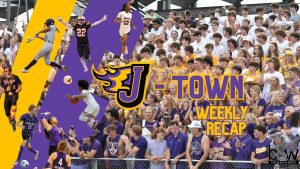J-town vs. small town
(left) provided by Leslie Dunbar (right) Joe Sprunger
On the left Bondurant’s student football section is compared to the student section of Johnston, on the right. Bondurant is classified as 2A school where as Johnston is a 4A school. The students’ attendance shows the difference in the size of the schools.
April 12, 2014
Johnston high school contains approximately 1,450 students altogether, with about 500 kids in each grade. Next year, there will be an estimated 1,535 students attending. To many students, these numbers mean limited seats in the cafeteria and less opportunities for classes and sports. Parking passes were tough to come by this year, and it will be even harder next year. Although a new high school is in the future, frustration seems to be common due to the large number of students in the school.
As student population grows each year, it’s natural for students to wonder if their high school experience would improve if they attended a smaller school. To find out if this is true, “The Black and White” went to Bondurant-Farrar high school for a day to see how it compared to Johnston.
Bondurant-Farrar high school is located north of Altoona, in a small suburban town with a student body of roughly 1,200 students kindergarten through 12th grade, only 500 freshmen through seniors in the high school. Because of fewer numbers of students, Bondurant was able to allow freshmen to attend the high school.
Upon arriving at Bondurant High School, parking was plentiful. There were no parking tags hanging from the rear view mirror compared to Johnston’s parking pass system, and no students’ cars were on the sides of the roads. “I would love to be able to just park at the school, without having to compete for a parking pass,” sophomore Brittney Biere said. “Instead, I have to walk from city hall to school everyday.” The limited parking space is not Johnston’s only overpopulated problem.
The overpopulated school has caused eating lunch in the lunchroom only accessible to those who can claim tables before others, with the exception of C lunch. Also many classes have a relatively high number of students in each class. In contrast, Bondurant’s classes and lunches are much smaller than those of Johnston. Every class averaged 20 kids with a comfortable learning environment. The cafeteria was also able to seat everyone.
Even in the small high school of Bondurant, cliques that are common in many high schools were still present. Unlike Johnston’s ‘don’t talk to them unless you have to’ stereotype that many cliques appear to follow, Bondurant’s different social groups seemed to intermingle with each other throughout the day. In the hallways students jokingly, lightly and casually talk to nearly every student they pass. “We know pretty much everybody in the school,” Bondurant freshman Mackenzie Clayton said. Many students in Johnston can attest that they have a tough time remembering a student’s name in their own grade.
With the openness of one student to another at Bondurant, a sense of casualness could be felt. A majority of the students were wearing sweatpants and t-shirts, many of them sporting their high school mascot, the Bluejays. However, many students at Johnston feel like it’s only socially acceptable to wear name brand products such as Miss Me jeans or Nike t-shirts. “I feel pressured to wear nice clothes, when all I really want to wear are sweats and a sweatshirt,” junior Nejra Cikotic said.
Bondurant begins class at 8:15 and releases at 3:20. Each day has eight 45 minute class periods. The day that the Black and White visited Bondurant was a Monday. Monday’s schedule for Bondurant is similar to Johnston’s Wednesday schedule so dismissal is an hour early. The classes that Bondurant offer include basic course classes found at Johnston, with a variety of other classes, such as Chinese, art, choir and other elective courses.
Teachers seemed to know each individual’s strengths and weaknesses in class, characteristics and have somewhat of an idea of the student’s personal life. “My art teacher is my favorite teacher,” Bondurant freshman Kendra Fulton said. “He throws parties on Fridays and is just really cool.”
However, Johnston offers more options in some areas. “I think the opportunity for clubs, the opportunity in some cases of class work, the opportunities to be around different kinds of kids and more diversity are all benefits of large schools,” high school Principal Brent Riessen said. School officials like Riessen, recognize the opportunity Johnston provides for students to learn more about different cultures.
Although small schools similar to Bondurant offer the basic core classes many high schools offer, they are not able to provide as many elective courses and other skilled courses as Johnston does. “We are trying to add more science classes and as we expand we are able to do that. The bigger we get the easier it is,” teacher’s associate Steve Skinner said. “When a student has a class they are interested in and we aren’t able to offer it, a lot of times they will be able to take it through DMACC.” Similar to classes, Bondurant does not offer as many sports as Johnston. Sports such as swimming, bowling, tennis, and fencing are unavailable. The students that want to participate in the sports not offered are able to join S. E. Polk’s sports teams.
“Smaller schools allow for more participation in extracurricular (activities) because they communicate and work together more than larger schools,” guidance counselor Curt Larkin said. This ensures that students would be able to get involved in a variety of activities like choirs, basketball, baseball, soccer, cross-country and other extracurriculars at the same time.
For as many students as Johnston has now, the number of students will only increase as the years go by. “Each year, we were the biggest class there has ever been,” Bondurant language arts teacher Leslie Dunbar said. Dunbar is a 1999 Johnston graduate that knows first hand how Johnston’s population gradually increased.
“Bondurant is growing too,” Dunbar said, “We will already need portables the year after next, and continue to grow even more after that.” Although the small school of Bondurant does not have a student population even near as big as Johnston’s, the school may someday become comparable in population.






